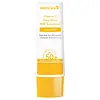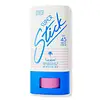What's inside
What's inside
 Key Ingredients
Key Ingredients

 Benefits
Benefits

 Concerns
Concerns

 Ingredients Side-by-side
Ingredients Side-by-side

Water
Skin ConditioningCyclopentasiloxane
EmollientEthylhexyl Salicylate
UV AbsorberSilica
AbrasiveButyl Methoxydibenzoylmethane
UV AbsorberOctocrylene
UV AbsorberButylene Glycol
HumectantGlycerin
HumectantHomosalate
Skin ConditioningOctyldodecanol
EmollientPolysorbate 20
EmulsifyingAmps/Hema Crosspolymer
C13-15 Alkane
SolventCoco-Glucoside
CleansingZinc Oxide
Cosmetic ColorantTitanium Dioxide
Cosmetic ColorantCetearyl Olivate
Sorbitan Olivate
EmulsifyingPanthenol
Skin Conditioning3-O-Ethyl Ascorbic Acid
Skin ConditioningPEG-2 Milk Solids
EmollientNiacinamide
SmoothingKojic Acid
AntioxidantXanthan Gum
EmulsifyingTocopheryl Acetate
AntioxidantDipotassium Glycyrrhizate
HumectantCeramide AP
Skin ConditioningCeramide NP
Skin ConditioningCeramide Eos
Skin ConditioningHyaluronic Acid
HumectantEthylhexylglycerin
Skin ConditioningPhenoxyethanol
PreservativeCitric Acid
BufferingWater, Cyclopentasiloxane, Ethylhexyl Salicylate, Silica, Butyl Methoxydibenzoylmethane, Octocrylene, Butylene Glycol, Glycerin, Homosalate, Octyldodecanol, Polysorbate 20, Amps/Hema Crosspolymer, C13-15 Alkane, Coco-Glucoside, Zinc Oxide, Titanium Dioxide, Cetearyl Olivate, Sorbitan Olivate, Panthenol, 3-O-Ethyl Ascorbic Acid, PEG-2 Milk Solids, Niacinamide, Kojic Acid, Xanthan Gum, Tocopheryl Acetate, Dipotassium Glycyrrhizate, Ceramide AP, Ceramide NP, Ceramide Eos, Hyaluronic Acid, Ethylhexylglycerin, Phenoxyethanol, Citric Acid
Butyl Methoxydibenzoylmethane 2.9%
UV AbsorberHomosalate 6.9%
Skin ConditioningEthylhexyl Salicylate 4.9%
UV AbsorberOctocrylene 8.6%
UV AbsorberAloe Barbadensis Leaf Juice
Skin ConditioningButyloctyl Salicylate
Skin ConditioningCalcium Sodium Phosphosilicate
Camellia Sinensis Leaf Extract
AntimicrobialCaprylic/Capric Triglyceride
MaskingCeramide Ng
Skin ConditioningCeramide NP
Skin ConditioningCetyl Esters
EmollientChlorella Vulgaris Extract
Skin ConditioningCocos Nucifera Oil
MaskingEthylhexylglycerin
Skin ConditioningParfum
MaskingGlycerin
HumectantHyaluronic Acid
HumectantLauroyl Lysine
Skin ConditioningMethylheptylglycerin
HumectantMusa Sapientum Fruit Extract
Skin ConditioningNiacinamide
SmoothingOlea Europaea Fruit Oil
MaskingPolyglyceryl-10 Caprylate/Caprate
EmulsifyingPolyurethane-35
Ricinus Communis Seed Oil
MaskingSaccharomyces Ferment
Skin ConditioningSodium Phytate
Sodium Stearate
CleansingSorbitan Olivate
EmulsifyingTapioca Starch
Tocopherol
AntioxidantTridecane
PerfumingTrimethylpentanediol/Adipic Acid/Glycerin Crosspolymer
Skin ConditioningUndecane
EmollientWater
Skin ConditioningButyl Methoxydibenzoylmethane 2.9%, Homosalate 6.9%, Ethylhexyl Salicylate 4.9%, Octocrylene 8.6%, Aloe Barbadensis Leaf Juice, Butyloctyl Salicylate, Calcium Sodium Phosphosilicate, Camellia Sinensis Leaf Extract, Caprylic/Capric Triglyceride, Ceramide Ng, Ceramide NP, Cetyl Esters, Chlorella Vulgaris Extract, Cocos Nucifera Oil, Ethylhexylglycerin, Parfum, Glycerin, Hyaluronic Acid, Lauroyl Lysine, Methylheptylglycerin, Musa Sapientum Fruit Extract, Niacinamide, Olea Europaea Fruit Oil, Polyglyceryl-10 Caprylate/Caprate, Polyurethane-35, Ricinus Communis Seed Oil, Saccharomyces Ferment, Sodium Phytate, Sodium Stearate, Sorbitan Olivate, Tapioca Starch, Tocopherol, Tridecane, Trimethylpentanediol/Adipic Acid/Glycerin Crosspolymer, Undecane, Water
Ingredients Explained
These ingredients are found in both products.
Ingredients higher up in an ingredient list are typically present in a larger amount.
Also known as Avobenzone, this ingredient is a chemical sunscreen filter that provides protection in the UV-A range.
Avobenzone is globally approved and is the most commonly used UV-A filter in the world.
Studies have found that avobenzone becomes ineffective when exposed to UV light (it is not photostable; meaning that it breaks down in sunlight). Because of this, formulations that include avobenzone will usually contain stabilizers such as octocrylene.
However, some modern formulations (looking at you, EU!) are able to stabilize avobenzone by coating the molecules.
Avobenzone does not protect against the UV-B range, so it's important to check that the sunscreen you're using contains other UV filters that do!
The highest concentration of avobenzone permitted is 3% in the US, and 5% in the EU.
Learn more about Butyl MethoxydibenzoylmethaneCeramide NP is a type of ceramide and formally known as ceramide 3.
Ceramides are intercellular lipids naturally found in our skin that bonds dead skin cells together to create a barrier. They are known for their ability to hold water and thus are a great ingredient for dry skin.
Ceramides are an important building block for our skin barrier. A stronger barrier helps the skin look more firm and hydrated. By bolstering the skin ceramides act as a barrier against irritating ingredients. This can help with inflammation as well.
If you would like to eat ceramides, sweet potatoes contain a small amount.
Read more about other common types of ceramides here:
Ceramide AP
Ceramide EOP
Ethylhexyl Salicylate is an organic compound used to block UV rays. It primarily absorbs UVB rays but offers a small amount of UVA protection as well.
Commonly found in sunscreens, Ethylhexyl Salicylate is created from salicylic acid and 2-ethylhexanol. You might know salicylic acid as the effective acne fighter ingredient and BHA.
The ethylhexanol in this ingredient is a fatty alcohol and helps hydrate your skin, similar to oils. It is an emollient, which means it traps moisture into the skin.
According to manufacturers, Ethylhexyl Salicylate absorbs UV wavelength of 295-315 nm, with a peak absorption at 307-310 nm. UVA rays are linked to long term skin damage, such as hyperpigmentation. UVB rays emit more energy and are capable of damaging our DNA. UVB rays cause sunburn.
Learn more about Ethylhexyl SalicylateEthylhexylglycerin (we can't pronounce this either) is commonly used as a preservative and skin softener. It is derived from glyceryl.
You might see Ethylhexylglycerin often paired with other preservatives such as phenoxyethanol. Ethylhexylglycerin has been found to increase the effectiveness of these other preservatives.
Glycerin is already naturally found in your skin. It helps moisturize and protect your skin.
A study from 2016 found glycerin to be more effective as a humectant than AHAs and hyaluronic acid.
As a humectant, it helps the skin stay hydrated by pulling moisture to your skin. The low molecular weight of glycerin allows it to pull moisture into the deeper layers of your skin.
Hydrated skin improves your skin barrier; Your skin barrier helps protect against irritants and bacteria.
Glycerin has also been found to have antimicrobial and antiviral properties. Due to these properties, glycerin is often used in wound and burn treatments.
In cosmetics, glycerin is usually derived from plants such as soybean or palm. However, it can also be sourced from animals, such as tallow or animal fat.
This ingredient is organic, colorless, odorless, and non-toxic.
Glycerin is the name for this ingredient in American English. British English uses Glycerol/Glycerine.
Learn more about GlycerinHomosalate is a chemical sunscreen filter that provides protection in the UV-B range (280nm - 320 nm), with a peak protection at 306 nm. It is internationally approved for use in sunscreens.
Homosalate is not photo-stable, meaning it's strength as a UV filter degrades over time with exposure to the sun. Because of this, it's often used in combination with other chemical sunscreen filters as avobenzone (which protects from the UV-A range). Homosalate also helps act as a solvent for harder-to-dissolve UV filters.
(Part of the reason that sunscreens need to be frequently re-applied is due to the photo instability of many chemical sunscreen filters)
Currently, homosalate is approved in concentrations up to 10% in the EU and 15% in the US. The FDA is currently doing further research on the effects of homosalate, and it is possible that these approved concentrations will change in the future.
Learn more about HomosalateHyaluronic acid is naturally found in healthy skin. It is a humectant, meaning it draws moisture to your skin.
This ingredient helps hydrate, soothe, and protect the skin.
What makes hyaluronic acid so hydrating? It has the capacity to bind or hold large amounts of water.
Fun fact: It is already naturally found in our bodies, such as the fluids of our eyes and our joints.
Studies find this ingredient to have anti-inflammatory and anti-microbial properties. This can help speed up wound-healing.
Hyaluronic acid can be irritating if the molecule has a low-molecular weight, or if the molecules are small.
One study found low-molecular weight hyaluronic acid to be pro-inflammatory, meaning some people may experience irritation. This is because our bodies use hyaluronic acid in the wound-healing process to signal to our bodies, via irritation, that something needs healing.
The same study found high-molecular weight hyaluronic acid to be anti-inflammatory.
These are some other common types of Hyaluronic Acid:
Learn more about Hyaluronic AcidNiacinamide is a multitasking form of vitamin B3 that strengthens the skin barrier, reduces pores and dark spots, regulates oil, and improves signs of aging.
And the best part? It's gentle and well-tolerated by most skin types, including sensitive and reactive skin.
You might have heard of "niacin flush", or the reddening of skin that causes itchiness. Niacinamide has not been found to cause this.
In very rare cases, some individuals may not be able to tolerate niacinamide at all or experience an allergic reaction to it.
If you are experiencing flaking, irritation, and dryness with this ingredient, be sure to double check all your products as this ingredient can be found in all categories of skincare.
When incorporating niacinamide into your routine, look out for concentration amounts. Typically, 5% niacinamide provides benefits such as fading dark spots. However, if you have sensitive skin, it is better to begin with a smaller concentration.
When you apply niacinamide to your skin, your body converts it into nicotinamide adenine dinucleotide (NAD). NAD is an essential coenzyme that is already found in your cells as "fuel" and powers countless biological processes.
In your skin, NAD helps repair cell damage, produce new healthy cells, support collagen production, strengthen the skin barrier, and fight environmental stressors (like UV and pollution).
Our natural NAD levels start to decline with age, leading to slower skin repair, visible aging, and a weaker skin barrier. By providing your skin niacinamide, you're recharging your skin's NAD levels. This leads to stronger, healthier, and younger looking skin.
Another name for vitamin B3 is nicotinamide. This vitamin is water-soluble and our bodies don't store it. We obtain Vitamin B3 from either food or skincare. Meat, fish, wheat, yeast, and leafy greens contain vitamin B3.
The type of niacinamide used in skincare is synthetically created.
Learn more about NiacinamideOctocrylene protects skin from sun damage. It absorbs UV-B with peak absorption of 304 nm. It is a common sunscreen ingredient and often paired with avobenzone, a UVA filter. This is because octocrylene stabilizes other sunscreen ingredients by protecting them from degradation when exposed to sunlight. Octocrylene is a photostable ingredient and loses about 10% of SPF in 95 minutes.
Octocrylene also acts as an emollient, meaning it helps skin retain moisture and softens skin. It is oil-soluble and hydrophobic, enhancing water-resistant properties in a product.
Those who are using ketoprofen, a topical anti-inflammatory drug, may experience an allergic reaction when using octocrylene. It is best to speak with a healthcare professional about using sunscreens with octocrylene.
The EU allows a maximum of these concentrations:
Learn more about OctocryleneSorbitan Olivate is created from the fatty acids in olive oil and sorbitol.
This ingredient is an oil in water emulsifier. It helps stabilize a product by preventing oils and waters from separating. Sorbitan Olivate also helps hydrate the skin.
Manufacturers sell sorbitan olivate under the name OliveM 1000. OliveM 1000 a multifunctional ingredient. It is self-emulsifying. According to a manufacturer, OliveM 1000 does not disrupt natural skin biome.
Due to its olive oil base, this ingredient may not be fungal-acne safe.
Learn more about Sorbitan OlivateWater. It's the most common cosmetic ingredient of all. You'll usually see it at the top of ingredient lists, meaning that it makes up the largest part of the product.
So why is it so popular? Water most often acts as a solvent - this means that it helps dissolve other ingredients into the formulation.
You'll also recognize water as that liquid we all need to stay alive. If you see this, drink a glass of water. Stay hydrated!
Learn more about Water